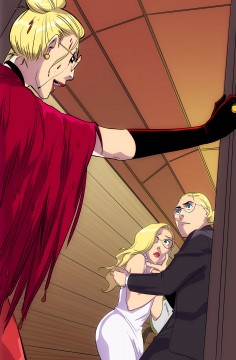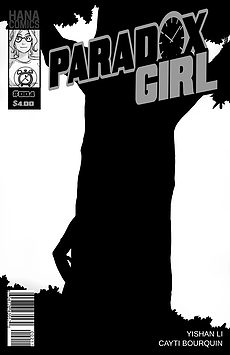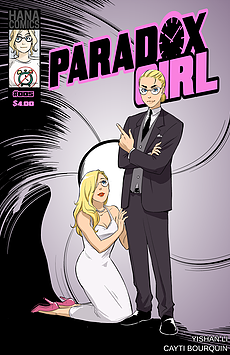“Her life is a mess because she’s gone back to fix every regret she’s ever had. ” Cayti Bourquin on the secrets of Paradox Girl
 Time travel is a funny old thing. Although it can add a little something extra to a humdrum tale, it can also turn a decent yarn into a convoluted mess. However rather than worry about the vagaries of the space time continuum, Cayti Bourgeon has embraced the confusion and created a heroine who is the living embodiment of a paradox. We try to make sense of the world of Paradox Girl.
Time travel is a funny old thing. Although it can add a little something extra to a humdrum tale, it can also turn a decent yarn into a convoluted mess. However rather than worry about the vagaries of the space time continuum, Cayti Bourgeon has embraced the confusion and created a heroine who is the living embodiment of a paradox. We try to make sense of the world of Paradox Girl.

Tell us a bit about the inspiration for Paradox Girl – was it the idea of time travel that was the initial spark or of a female superhero engaging in arguments with herself?
Cayti Bourquin: Myself mostly. Someone who was in conflict with herself, feeling guilty for wanting things, feeling angry about being envious, fighting to be perfect-but a flawed version of it. This was expressed originally as a character that was a reformed demon who’d become catholic (even though the crosses burned her and such). The idea was that true chaos isn’t predictable, so it can’t always be evil, it can’t always be anything. A walking paradox
It was a way of dealing with my own existential angst, and was super pretentious and haughty and awful. As I grew older, the edges of it came off a bit, and it went from this goth/emo self hating conflict to the light hearted comedy of the living paradox. Though time travel paradoxes show up frequently in PG, they’re not the only kind of paradoxes she ends up in!
You manage to handle the time travel elements really well and not make them too paradoxical – unless they need to be. Do you have rules for how the time travel elements will work or was the whole point of creating a character called Paradox Girl so that you didn’t have to worry about such delicacies as logic?!
CB: Ha! Good question, and thank you! The first issue sort of wrote itself, and I didn’t struggle very much with making the pieces fit together. Looping back on herself is sort of a given, and in Issue 1 we get to follow her every step of that way, seeing how she’s everyone of the PGs that we see during the ‘day’. Issue 2 is more of a closed loop and starts where it ends. Issue 3 – we never really follow PG through her day, we just get a chronologically scattered story as she tries to relate what’s really going on-in the only way she knows how.
I guess to answer your question more directly, there are ‘rules’, in as such that the audience needs to be able to understand. We rarely see the other timelines before PG interferes in them, we only see the end result, so from an audience’s perspective the causality of things seems natural, we can trace the events, even when they go in circles. From a logical standpoint, it’s impossible-but that’s some of fun of it. It can connect and ‘make sense’ even if there’s no logical way to reproduce that chain of causality from the beginning. One of my favorite lines is from Issue 1, where PG asks “Do you know what happens when you violate causality? By definition: nothing.”

I really want the ride to be fun for the reader, but part of that means changing up the formula and never being quite predictable. There are also some paradoxes between the issues-like, PG unleashes Stompzilla during her chaotic night in issue 2-which causes her house to be destroyed-but her house isn’t destroyed in issue 1- so the two issues are in conflict with each other. They can’t both have happened, and yet, they both sort of ‘do’.
How did you and artist Yishan Li come to work together on this? Was she always part of the team when you first created the character?
CB: The original script for “A Day in the Life of a Paradox” was written in 2010 I believe? An industry outsider, I had no idea really what to do with the script or who would be interested in it. I thought about commissioning an artist to make the comic real, but that was going to be expensive even before printing. Peter Bensley over at Hanako Games was a close friend and loved the script and after getting some advice from some industry people, he started attending conventions, looking for an artist whose style could capture the vibrant chaos of PG.
There were a couple of artists we looked at then, but Yishan’s character sketches really captured the energy of the character and I was instantly in love. She’s done an incredible job bringing PG to life.
She has a very Japanese/Manga/Anime infused style, did you always want that style for the book? It seems to fit the zany style of the story in a way that a more western art style might not have been able to get across?
CB: When thinking about artists, our original inspiration was Amanda Connor. So we weren’t necessarily looking for a Manga style artist. Yishan’s style really works though, because she’s able to express so much with PG’s face and eyes.

You are Kickstarting issues #4-6 at the moment, why are you choosing to do 3 issues in one go rather than the individually? And what can we look forward to in the new issues? Will it be more a longer arc rather than the individual issues that we have seen to date. And will we get to meet any new characters or learn more about her origins?
CB: So, after we finished issue 1, we realized we had something really special on our hands, and Hanako Games branched out to be Hana Comics as well and put an order for 6 issues for me and Yishan. The issues have been done for roughly a year now, but printing,bringing the comics to market, finding an audience were all sort of a mystery to us. Our first Kickstarter last January was a huge hit and we went from just doing issues 1 and 2, to doing 1-3. This time we wanted to complete the first ‘cycle’, and give people the remaining 3 issues before looking at ‘is there an audience here, can we do more?’
Next issues, well, we’ll get into some of the deeper stuff about PG and the perils of being timeless. We’ll have a few wacky adventures, introduce a new character in the PGVerse, and bring the first cycle to a close. You ask about arcs, but one of the goals with PG is to make sure that each issue is completely self contained. There isn’t even a necessary order to reading them. The issues happen in conflict with each other or sometimes in parallel with each other. The first six issues are all connected, in lots of tiny ways. PG doesn’t have a ‘story’ – or rather, PG’s story isn’t one that’s told narratively. We won’t ever learn her orgins, because there isn’t one anymore. There’s a thousand, it’s always changing. PG doesn’t have a beginning anymore because she’s rewritten it so many times. (Warning: this is satire of mainstream comics) So she doesn’t even know if she has a name besides PG.
So, no, sadly, we won’t see where she starts, but maybe if we get to do another cycle of 6 we’ll get to see more about her growth as a person without time, and eventually see how her story ends. I have in mind a closing arc called ‘Crisis on Infinite Girls’, and I’m hoping I get to tell that story at some point.

Do you have any top tips on how to run a successful Kickstarter?
CB: We hired some experts (SquidAndCrow) to teach us what to do and what not to do. Sara has been invaluable in the process. I really have no idea to be honest how to run a successful Kickstarter? I could say ‘have the best product in the world’, but that would be immodest and unhelpful! Kickstarter is tricky and I’m glad we’ve had such an amazing team to put everything together.
And finally if you could travel in time like Paradox Girl, where and when would you go?
CB: So Paradox Girl’s life is a mess because she’s gone back to fix every regret she’s ever had. It’s paralyzing to think about having that sort of power. I think the best answer, though boring, is to say “I wouldn’t” I wouldn’t want to change who I am and the connections with the people I have around me. I am who I am today as a result of the domino of choices up to this point.
The less pretentious and sillier answer is that I’d go back in time and make sure the Back to the Future II script takes place in 2016 so that the Cub’s win prediction comes true properly.
You can back Paradox Girl #4, 5 and 6 on Kickstarter here. And for more info on issue #1-3 then visit www.paradoxgirl.com


